“That acceleration wasn’t just kinetic — it was cognitive. Each successful hit degraded enemy decision cycles, confused their tempo, and fractured their internal command AI. MDTF wasn’t just fighting their force. It was fighting their feedback loop. Victory didn’t hinge on territory, but on tempo dominance and informational dissonance.”
[Editor’s Note: Crowdsourcing and story telling remain two of Army Mad Scientist’s most effective tools for envisioning future possibilities and exploring the evolving Operational Environment.
Crowdsourcing involves the gathering of ideas, thoughts, and concepts from a widespread variety of interested individuals assists us in diversifying thought and challenging assumptions.
Story telling via creative fictional writing and narrative building helps us see how new technologies could be employed and operationalized.
This past spring, we converged these two complementary future-casting tools in our Great Power Competition & Conflict Writing Contest and provided our community of action with the following four writing prompts:
How are the ongoing conflicts in Ukraine, the Middle East, and Africa shaping how the U.S. Army may need to fight in 2035?
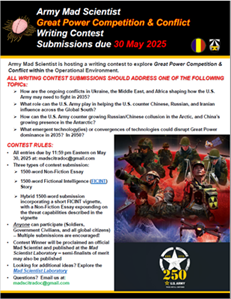 What role can the U.S. Army play in helping the U.S. counter Chinese, Russian, and Iranian influence across the Global South?
What role can the U.S. Army play in helping the U.S. counter Chinese, Russian, and Iranian influence across the Global South?
How can the U.S. Army counter growing Russian/Chinese collusion in the Arctic, and China’s growing presence in the Antarctic?
What emergent technology(ies) or convergences of technologies could disrupt Great Power dominance in 2035? In 2050?
We solicited three types of submissions:
-
-
- 1500-word Non-Fiction Essay
- 1500-word Fictional Intelligence (FICINT) Story
- Hybrid 1500-word submission incorporating a short FICINT vignette, with a Non-Fiction Essay expounding on the threat capabilities described in the vignette
-
In all, we received 26 submissions — a hearty Mad Scientist “thank you!” goes out to everyone who took the time to cogitate on, then craft and submit their creative pieces exploring one or more of these writing prompts for our review! You have all helped broaden our understanding of the Operational Environment and its associated future possibilities.
Mad Scientist Laboratory is pleased to feature the contest’s winning submission as today’s guest blog post. Brigadier General Terri Borras‘ story (one of six — a new crowdsourcing record by a single contributor!) explores how the U.S. Army of 2035 could assimilate the lessons learned from contemporary conflicts like Ukraine and Gaza with emergent battlefield automation and edge networking technologies. Envisioning tomorrow’s resilient Multi-Domain Task Force (MDTF), BG Borras posits a future force empowered by a new “Adaptive Tempo Warfare” doctrine — “blend[ing] … terrain denial, partner warfare, and cognitive synchronization” via “AI-optimized and distributed mission command” and “cognitive interoperability.” Read on to learn how the U.S. Army maintains “our decisive edge in 2035”!)
Location: Trans-Sahelian Corridor, West Africa | Year: 2035
 The fine grit of the Sahel crept into everything. Even the autonomous filtration units mounted on the Joint All-Domain Command Node — codenamed “Beacon” — struggled to keep the dust from fouling optics and clogging drone ports. Major Erika Moreno, 5th Multi-Domain Task Force (MDTF), stood atop the retrofitted M-127 “Tempest” hybrid command vehicle, surveying the fractured urban sprawl of Kidal through the haze of a high-altitude wildfire.
The fine grit of the Sahel crept into everything. Even the autonomous filtration units mounted on the Joint All-Domain Command Node — codenamed “Beacon” — struggled to keep the dust from fouling optics and clogging drone ports. Major Erika Moreno, 5th Multi-Domain Task Force (MDTF), stood atop the retrofitted M-127 “Tempest” hybrid command vehicle, surveying the fractured urban sprawl of Kidal through the haze of a high-altitude wildfire.
The smoke wasn’t just from wildfires. It was from overloaded generators, detonation remnants, and garbage fires lit by displaced families sheltering in roofless buildings. There was no clear frontline here — just edges of influence, shifting daily. In Kidal, the future was a patchwork: schoolchildren walking to class past armed drones, elders livestreaming sermons on cracked solar screens, militias offering security in exchange for data ports and access corridors. The scars of collapse and adaptation were visible in every direction.
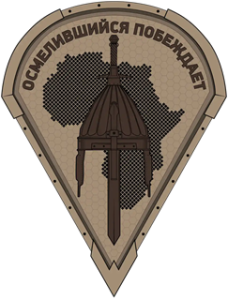 Her voice crackled through the neural-linked HUD of her squad leaders. “Eagle-7 to all elements. ISR confirms Russian-backed Private Military Company (PMC) fortification in Sector Delta-3. Civilian signature minimal. Rules of engagement still apply. Prep for a contested push.”
Her voice crackled through the neural-linked HUD of her squad leaders. “Eagle-7 to all elements. ISR confirms Russian-backed Private Military Company (PMC) fortification in Sector Delta-3. Civilian signature minimal. Rules of engagement still apply. Prep for a contested push.”
Twenty-five years of watching the world fracture had culminated in this mission: a joint U.S.–African Union operation to deny the Trans-Sahelian corridor to the Wagner Group’s successor — an amorphous network of Russian-Iranian backed militias equipped with loitering munitions, AI-enabled mortar guidance, and black-market Chinese robotics. The chaos of Ukraine, Gaza, and Mali had become a recipe — one the U.S. Army was now built to counter. A blend of terrain denial, partner warfare, and cognitive synchronization.
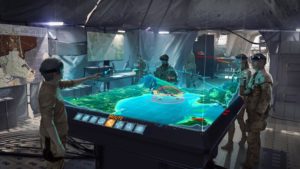 Moreno dropped back into the command node, where holographic overlays mapped the city in 3D. The mission was “multi-domain combat in cluttered battlespace,” but the Army’s new doctrine — Adaptive Tempo Warfare — had shifted away from static kill chains. Here, tempo wasn’t just speed. It was rhythm. Flow. A dynamic dance between human and machine. Decisions were delegated to the edge. Authority was earned by proximity to truth.
Moreno dropped back into the command node, where holographic overlays mapped the city in 3D. The mission was “multi-domain combat in cluttered battlespace,” but the Army’s new doctrine — Adaptive Tempo Warfare — had shifted away from static kill chains. Here, tempo wasn’t just speed. It was rhythm. Flow. A dynamic dance between human and machine. Decisions were delegated to the edge. Authority was earned by proximity to truth.
Sergeant First Class Isaiah Trent, her MDO NCO, leaned in. “Ma’am, our decoy drones triggered two auto-artillery sites. Confirmed Type-27s. Iranian make. Mid-range ISR crossfire net. Looks like they’re shielding a logistics pocket.”
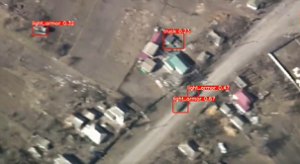 “Means they’re guarding something.” Moreno swiped a finger to redirect a fire team of AI-paired Spotter-Bots toward a derelict school complex. “Push Charlie Team into overwatch. And light up the quantum-hardened fog net — no more dead zones.”
“Means they’re guarding something.” Moreno swiped a finger to redirect a fire team of AI-paired Spotter-Bots toward a derelict school complex. “Push Charlie Team into overwatch. And light up the quantum-hardened fog net — no more dead zones.”
Trent hesitated. “We’re still blind on the south vector. Local militia’s jamming our node-to-node mesh.”
Moreno smirked. “Then we plug into theirs.”
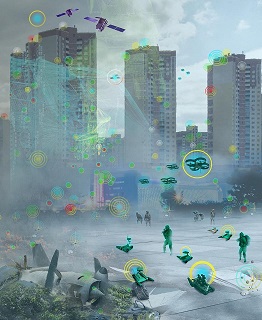 She’d learned this in Gaza, 2026, when her platoon was pinned by neural-swarm mines seeded by Iran’s Quds Force proxies. Local resistance fighters had been key — not by loyalty, but by infrastructure. The Army of 2035 had learned not to rebuild networks but to hitchhike on whatever existed. Elastic sovereignty. Operational empathy. It wasn’t about who owned the network. It was about who understood it.
She’d learned this in Gaza, 2026, when her platoon was pinned by neural-swarm mines seeded by Iran’s Quds Force proxies. Local resistance fighters had been key — not by loyalty, but by infrastructure. The Army of 2035 had learned not to rebuild networks but to hitchhike on whatever existed. Elastic sovereignty. Operational empathy. It wasn’t about who owned the network. It was about who understood it.
Private Lamine Diallo, a native of Senegal, now part of the 9th Coalition Human-Machine Recon Element, launched his embedded translator suite. “Tapping into Sidi Ali’s militia comms now,” he muttered, fingers dancing on his wristpad.
The feed came alive: overlapping voices in Hausa, French, Arabic. Jargon-rich, but the Army’s language models parsed the signal. They were preparing a counteroffensive — against the same PMC that the MDTF was targeting.
“We have a convergence,” Moreno said, eyes lighting up.
This was what the old Army had missed.
The MDTF doctrine didn’t view enemies and allies in binary. Everything was situational alignment. If the objective aligned with local interests, even temporary cooperation was worth more than years of strategic messaging. Cooperation by mission, not by allegiance. Tactical coalitions that lasted as long as the shared threat did.
She opened a secure line. “Task Bravo, this is Eagle-7. Prepare to initiate Joint Action Flex Package 04 — ‘Ghost Net Alpha.’ We go in as shadows. Let Sidi Ali’s people draw the heat.”
“Copy that,” replied Lieutenant Samir Hassan from the integrated cyber-electronic warfare detachment. “Deploying mimic nodes and passive reverb –won’t even know we’re there.”
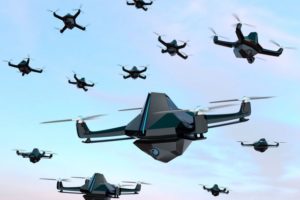 Outside, ghost-gray quadcopters lifted, linking into the mesh of militia drones. Their signatures mimicked the PMC’s own, sowing confusion. The school was now in play. Enemy systems might target their own by mistake, and the chaos would serve them.
Outside, ghost-gray quadcopters lifted, linking into the mesh of militia drones. Their signatures mimicked the PMC’s own, sowing confusion. The school was now in play. Enemy systems might target their own by mistake, and the chaos would serve them.
At the forward edge of the sector, Specialist Noa Park crouched behind a solar panel array, manually guiding her swarmlet of “Tick” drones — thumb-sized bots with haptic feedback. Their mission was to detect sub-surface movements — PMC tunnels, a favorite tactic born from years of urban combat in Ukraine and Mosul.
“Got vibration patterns. Resonant footprint says… fuel cache. Possibly a buried logistics node.”
Her platoon leader confirmed. “Relay to StrikeCell-3.”
Above, a hypersonic loitering munition — Phoenix-9, developed after the costly battles of Bakhmut and Kharkiv — adjusted trajectory. These weren’t fire-and-forget anymore. The munition synced with ISR, adjusted in real time, and even negotiated legal parameters based on on-board combat ethic algorithms.

The cache detonated with a muffled thunder, rippling sandbags like waves. Secondary explosions followed. The enemy’s mobility had just taken a serious hit.
Park tapped her neural link. “Mission Kill on Logistics Point Bravo.”
“Roger,” came Moreno’s voice. “We’re accelerating the push.”
That acceleration wasn’t just kinetic — it was cognitive. Each successful hit degraded enemy decision cycles, confused their tempo, and fractured their internal command AI. MDTF wasn’t just fighting their force. It was fighting their feedback loop. Victory didn’t hinge on territory, but on tempo dominance and informational dissonance.
Back at Base Echo, General Amari Sika, AU Defense Forces, watched the feed with quiet intensity. “Your Army,” she said, “has finally learned to bend.”
Moreno nodded. “We had no choice. Ukraine showed us that brute force alone won’t win. Gaza taught us that precision isn’t just about tech, but timing. And Africa… Africa reminds us the environment decides the tempo.”
Sika gestured to the 3D map, where local militias, Coalition advisors, and semiautonomous U.S. fire teams maneuvered like a jazz ensemble. “This is decentralized command with centralized intent.”
“Mission command,” Moreno said. “But evolved. We let the edge nodes make decisions. Humans make the calls that matter. The rest — recon, fire solutions, logistics — it’s AI-optimized and distributed.”

Sika nodded. “It’s working.”
Later that evening, as the sky darkened and winds cooled the air, Moreno walked the outskirts of the Kidal node. A local imam approached, holding a thermos of strong mint tea.
“For the warriors who stayed to clean the dust,” he said, pouring two cups.
Moreno accepted one with a smile. It was a small gesture, but in the Sahel, gestures meant everything. Where narratives shifted like the sand, trust was currency. She took a sip. The tea was strong, bitter, and perfect.
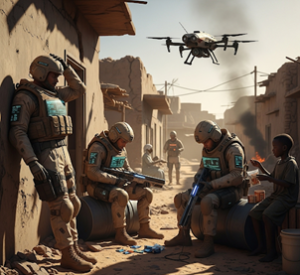 Two hours later, the node was secure. No parades, no flags. Just exhausted Soldiers sipping nutrient packs while drones swept for residual threats. The AI-paired logistics trains hummed silently in the background, refitting units before they even requested it.
Two hours later, the node was secure. No parades, no flags. Just exhausted Soldiers sipping nutrient packs while drones swept for residual threats. The AI-paired logistics trains hummed silently in the background, refitting units before they even requested it.
Moreno stepped out into the dusk. The fires had calmed. A child ran across the square chasing a robo-mule carrying water. The same mule, yesterday, had carried ammunition. Dual-use wasn’t a concept here. It was a way of life.
She watched the sunset spill across the rooftops, burnt orange and restless. Crickets chirped. For the first time in three days, there were no alerts in her HUD. Just breathing. Just silence.
Sergeant Trent joined her, eyes red but focused. “You think this holds?”
Moreno exhaled. “For now. Until the next adaptation.”
“They’re not going to stop.”
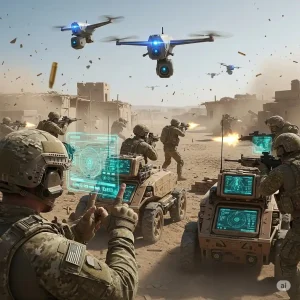 “No,” she said. “But neither will we. The point isn’t holding the city. It’s holding the initiative.”
“No,” she said. “But neither will we. The point isn’t holding the city. It’s holding the initiative.”
He nodded slowly. “Feels like we’re writing doctrine in real time.”
“We are,” she replied. “Because we’re not fighting yesterday’s war anymore.”
In a secure message, she drafted her after-action report for the Army Transformation and Training Command:
“Operations in Kidal demonstrate the necessity of tempo-fluid doctrine that fuses urban warfare, indigenous partnerships, and distributed AI-driven logistics. Lessons from Ukraine inform our understanding of attritional saturation; Gaza reaffirms the legal ethical complexities of high-density urban ops; and the Sahel proves that cognitive interoperability — between human, machine, and culture — is our decisive edge in 2035.”
She paused, then added:
 “Victory will not be measured by flags planted, but by futures enabled. The next war may look different. But the tools — trust, timing, and tempo — remain constant.”
“Victory will not be measured by flags planted, but by futures enabled. The next war may look different. But the tools — trust, timing, and tempo — remain constant.”
She hit send. The war wasn’t over.
But maybe, just maybe, they were finally fighting it the right way.
If you enjoyed this post, check out the TRADOC Pamphlet 525-92, The Operational Environment 2024-2034: Large-Scale Combat Operations
Explore the TRADOC G-2‘s Operational Environment Enterprise web page, brimming with authoritative information on the Operational Environment and how our adversaries fight, including:
Our China Landing Zone, full of information regarding our pacing challenge, including ATP 7-100.3, Chinese Tactics, How China Fights in Large-Scale Combat Operations, BiteSize China weekly topics, and the People’s Liberation Army Ground Forces Quick Reference Guide.
Our Russia Landing Zone, including the BiteSize Russia weekly topics. If you have a CAC, you’ll be especially interested in reviewing our weekly RUS-UKR Conflict Running Estimates and associated Narratives, capturing what we learned about the contemporary Russian way of war in Ukraine over the past two years and the ramifications for U.S. Army modernization across DOTMLPF-P.
Our Iran Landing Zone, including the Iran Quick Reference Guide and the Iran Passive Defense Manual (both require a CAC to access).
Our North Korea Landing Zone, including Resources for Studying North Korea, Instruments of Chinese Military Influence in North Korea, and Instruments of Russian Military Influence in North Korea.
Our Irregular Threats Landing Zone, including TC 7-100.3, Irregular Opposing Forces, and ATP 3-37.2, Antiterrorism (requires a CAC to access).
Our Running Estimates SharePoint site (also requires a CAC to access) — documenting what we’re learning about the evolving OE. Contains our monthly OE Running Estimates, associated Narratives, and the quarterly OE Assessment TRADOC Intelligence Posts (TIPs).
Then check out the following Mad Scientist Laboratory blog posts associated with previous writing contests:
OE Wicked Problems:
Baltics, August 2040: Asymmetric Envelopment, by proclaimed Mad Scientist LTC Matt Rasmussen
Weapons on Demand: How 3D Printing Will Revolutionize Military Sustainment, by Scott Pettigrew
Operation Northeast Monsoon: The Reunification of Taiwan, by Sherman Barto
The Future of the AI Battlefield:
Takeaways Learned about the Future of the AI Battlefield
The Guy Behind the Guy: AI as the Indispensable Marshal, by Brady Moore and Chris Sauceda
The Human Targeting Solution: An AI Story, by CW3 Jesse R. Crifasi
Back to the Future:
Task Force Wolf, by proclaimed Mad Scientist LTC Daniel Gomez
The Operational Environment: What Will Change and What Will Drive It – Today to 2035?
Splinternets, by proclaimed Mad Scientist Howard R. Simkin
The Operational Environment in 2035 Writing Contest:
Louisiana Maneuvers for the Age of Artificial Intelligence, by proclaimed Mad Scientist MAJ Michael B. Kim
The Information Disruption Industry and the Operational Environment of the Future, by proclaimed Mad Scientist Vincent H. O’Neil
Military Implications of Smart Cities, by Alexander Braszko, Jr.
Information Warfare Vignettes Writing Contest:
Three Best Information Warfare Vignettes, by proclaimed Mad Scientist Davis Ellison, Tony Stark, and Rob Kunzig
Competition, Crisis, Conflict, and Change Writing Contest:
The U.S. Joint Force’s Defeat before Conflict, by proclaimed Mad Scientist CPT Anjanay Kumar
The Future of War is Cyber! by CPT Casey Igo and CPT Christian Turley
A House Divided: Microtargeting and the next Great American Threat, by 1LT Carlin Keally
CALLING ALL CREATORS ~ An Army Mad Scientist Multi-Media Contest:
Kryptós, by proclaimed Mad Scientist CPT Katherine Hathaway
2nd Dense Urban Armored Brigade (DUAB) Personnel Evaluations, by Ed dos Santos, Jr.
Fall / Winter 2021 Writing Contest:
OASIS: A North American Proving Ground, by proclaimed Mad Scientist Steve Pomper
The Army’s Next Failed War: Large Scale Combat Operations, by proclaimed Mad Scientist MAJ Anthony Joyce
On Surprise Attacks Below the “Bolt from the Blue” Threshold, by Lesley Kucharski
About the Author: Brigadier General Terri Borras has spent over four decades fighting wars most people can’t see – across cognitive, emotional and informational terrain. She doesn’t chase disruption. She engineers it. Her specialty? Bending friction and ambiguity into mission fuel. Current assignment: Translating entropy into advantage. Next Objective: Weaponize trust. Mobilize meaning. Outmaneuver chaos.
Disclaimer: The views expressed in this blog post do not necessarily reflect those of the U.S. Department of Defense, Department of the Army, Army Futures Command (AFC), or Training and Doctrine Command (TRADOC).

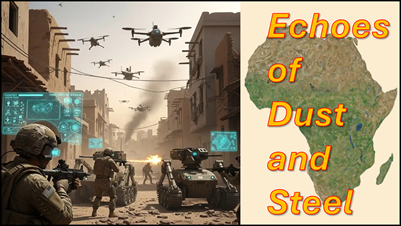


How does one get invited to submit to this competition for the future?
Stay tuned for announcement on this blog space!